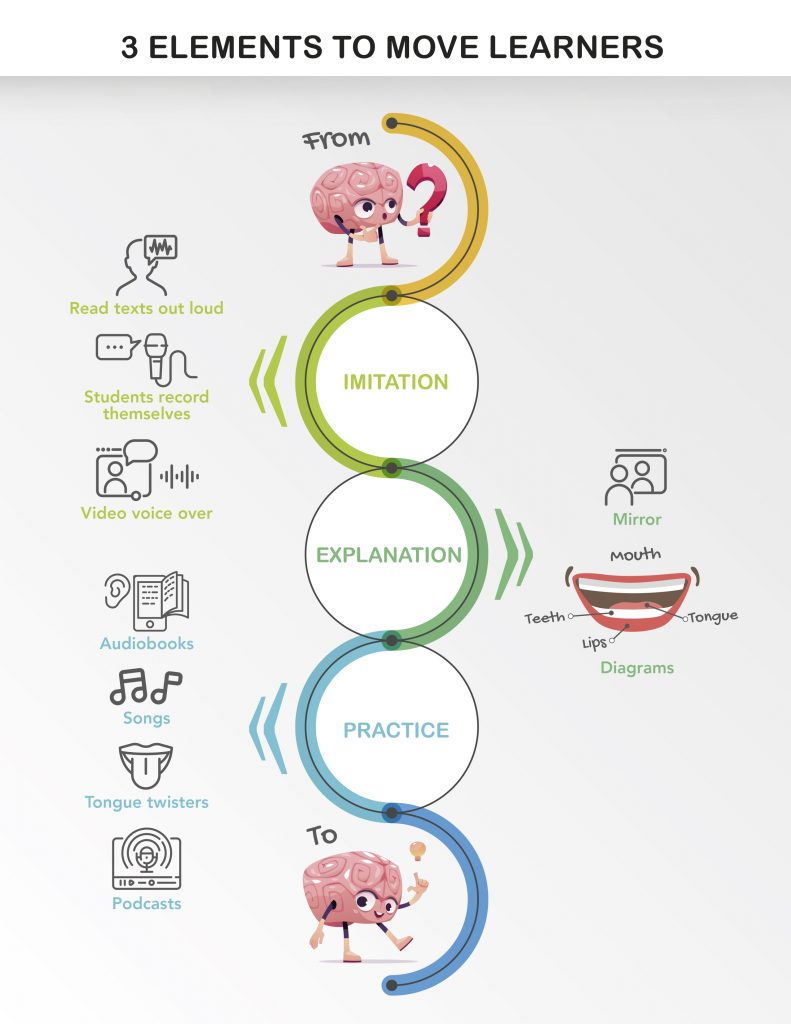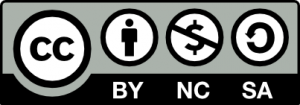Avant de débuter la lecture…
Do you think that your students’ communication skills will improve with better pronunciation?
Enseigner la prononciation explicitement (ALS)
I say to-ma-to, you say to-mayto
təˈmeɪtəʊ təˈmɑːtəʊ

How crucial do you believe it is to teach pronunciation explicitly?
Do you think that your students’ communication skills will improve with better pronunciation?
Where to start?
The best way to start is to take an « audio » portrait of your students at the beginning of their course. Identify their pronunciation challenges and address those, one at a time. Every person will have different pronunciation challenges; some factors that can affect their pronunciation are their age, native tongue [C1] and motivation to learn the new language.
Three essential elements to teach pronunciation: imitation-explanation-practice.
Imitation
Expose students to authentic speech and train them to hear the different sounds and stress patterns of the language. Just as reading helps to become a better writer, being a good listener helps to become a better speaker.
Some ideas to do in class:
- Read out loud and record a text (1-3 sentences). Ask your students to listen to the text, instructing them that they will have to imitate you. Then have them read and record the same text. Let them compare the recordings. They can do this exercise with almost any audio or multimedia resource.
- In pairs, have them watch a short video extract several times. Then, turn off the sound. Turn on the subtitles and ask them to choose a character. Then, let them have fun by doing the voice over for the video.
- Repeat the same sentence several times, but change the intonation to reflect a different mood or intention (angry, happy, timid, confident, question, etc.). Have them repeat one after the other or as a group.
Explanation
Once they have tried to imitate, explain what physically happens when you pronounce different sounds. It can be helpful to print out a mouth diagram to show the position of the mouth and the tongue when each sound is produced.
https://www.englishcentral.com/browse/videos (pronunciation tab). This site has many videos to explain how to pronounce different sounds.
Some ideas to do in class:
- Have hand-held mirrors to help them see their mouth and tongue position when they are having difficulty with a particular sound.
- Have them experiment with the « magic-e » turning short vowels into long vowels. Short vowels vs long vowels. For example, bat vs bate, rat vs rate, cut vs cute. Ask them to identify what differences occur in the position of their mouth and tongue.
- Choose one sound per week and work with minimal pairs to help them feel the different sounds. Lists of minimal pairs
- Explain the « schwa » that neutral vowel sound for unstressed vowels. Examples, choc(o)late, cam(e)ra, separ(a)te.
Practice
After imitating and understanding the mechanics of pronunciation, it is time for practice. Some key elements to help get the most out of each practice:
- Keep traces of students’ practices with audio or multimedia recordings.
- Show them how to use different resources to hear/know the pronunciation of new words. Here are some examples.
- Use of the phonetic IPA alphabet chart (for students)
- PRONUNROID android app to help learn IPA
- Most online dictionaries offer the option to hear the word.
- Other online resources such as Duolingo, Babble and YouGlish
- Encourage the use of resources that offer prompt feedback. If they are talking with you, take notes of mispronounced words. Show learners the correct pronunciation as soon as they are done speaking.
- Have useful resources on hand to share with students according to their specific needs.
Some ideas to do in class:
- Minimal pair
- Use cellphones as audio recorders for individual practice or pair discussions. Keep recordings to document progress.
- Google Docs –Tools- Voice typing. Students speak, and Google types the text. This tool will help students « see » which words still need work to be understood correctly.
- Audiobooks: Give them the chance to listen to audiobooks or podcasts of their choice (the last 10-20 minutes of the course is often a good time). Listening will help them with word/sentence stress, intonations and rhythm of the language.
- Songs: singing and music is not only fun but also quite effective to help increase memory and decrease stress. com is a great place to start (beginner, intermediate and advanced levels). Lyrics.com to find the lyrics of songs. Students can find, modify or add rhymes using popular lyrics.
- Tongue twisters are great as brain breaks. Find different tongue twisters. Divide your class into smaller groups, give each person a different tongue twister. Members of the group take turns saying their tongue twister (at least three repetitions).
- Pronunciation flashcards or posters. Here is an example of the « ed » pronunciation of the simple past regular verbs.
What is the impact of teaching pronunciation?
The impacts of not teaching pronunciation are a higher risk of misunderstandings and communication breakdowns. Bad pronunciation is more harmful to communication skills than poor grammar. Even if the learner has an expansive vocabulary and a strong knowledge of grammar, if the words are not understandable, communication will be hindered.

Helping language learners to pronounce clearly and intelligibly will help them build their confidence as speakers. The more they are understood, the more they will want to speak, and the more competent they will become in the target language.
Resources to go further
- The Busy Teacher.org : This website has many interesting teaching resources. For pronunciation, two are particularly relevant: « Hear and Say » and « How to Teach Pronunciation Like a Pro. »
- How Can EFL Teachers Help EFL Learners Improve Their English Pronunciation?
- How to Teach Pronunciation- The Accent’s Way (14:33) : This teacher shares her experience of teaching pronunciation. She explains 5 of her 8 p’s in pronunciation.
Ressources créées par :
- Janie Lamoureux, conseillère pédagogique Équipe-choc pédagogique et enseignante CSSMI
- Sonia Boulais, infographiste CSSMI
Remerciements particuliers :
- Vanessa Boily, conseillère pédagogique Équipe-choc pédagogique
- Marie-Ève Ste-Croix, conseillère pédagogique RÉCIT FGA (courriel, twitter, site Web)
Si vous souhaitez plus d’informations sur ces ressources ou si vous souhaitez ajouter quelque chose à cette céramique, veuillez contacter l’un des conseillers mentionnés ci-dessus. Toutes les ressources doivent être réutilisées et partagées conformément à la licence Creative Commons suivante : CC BY-NC-SA 4.0


